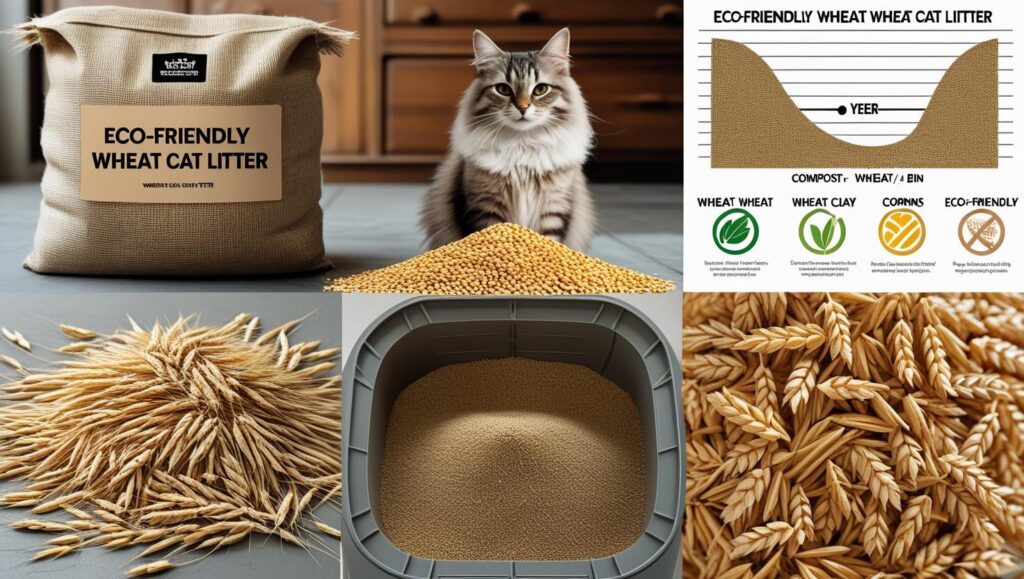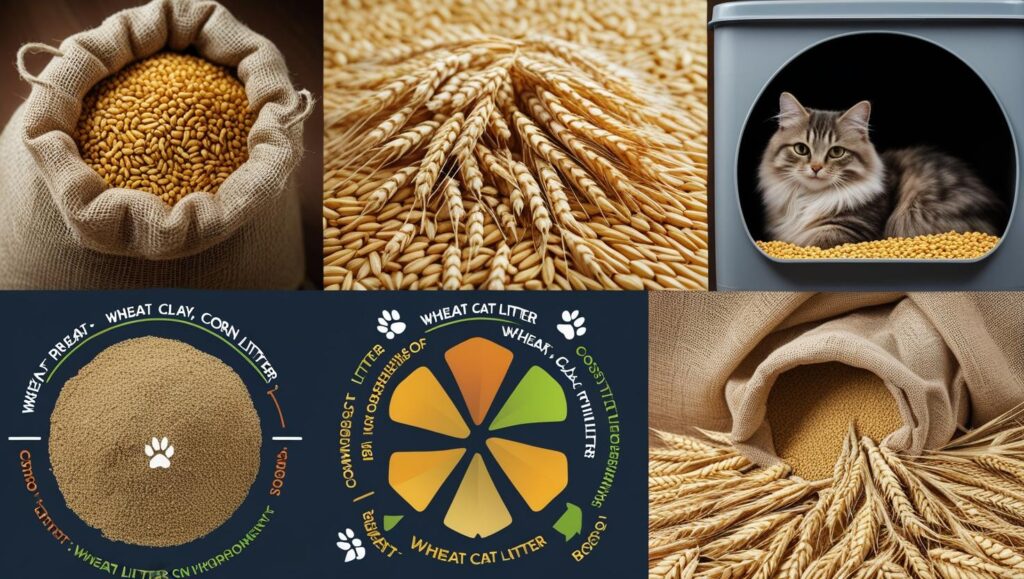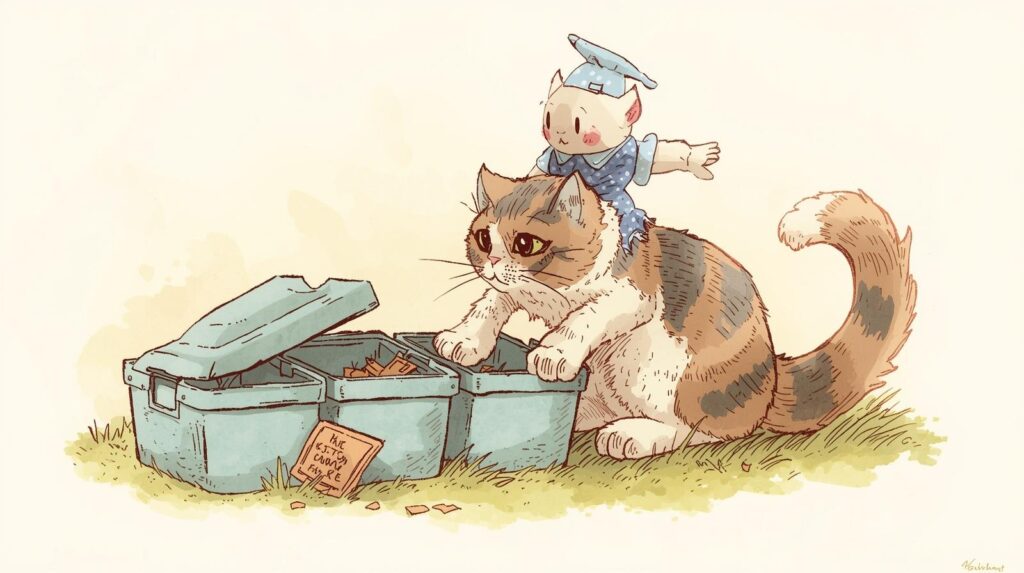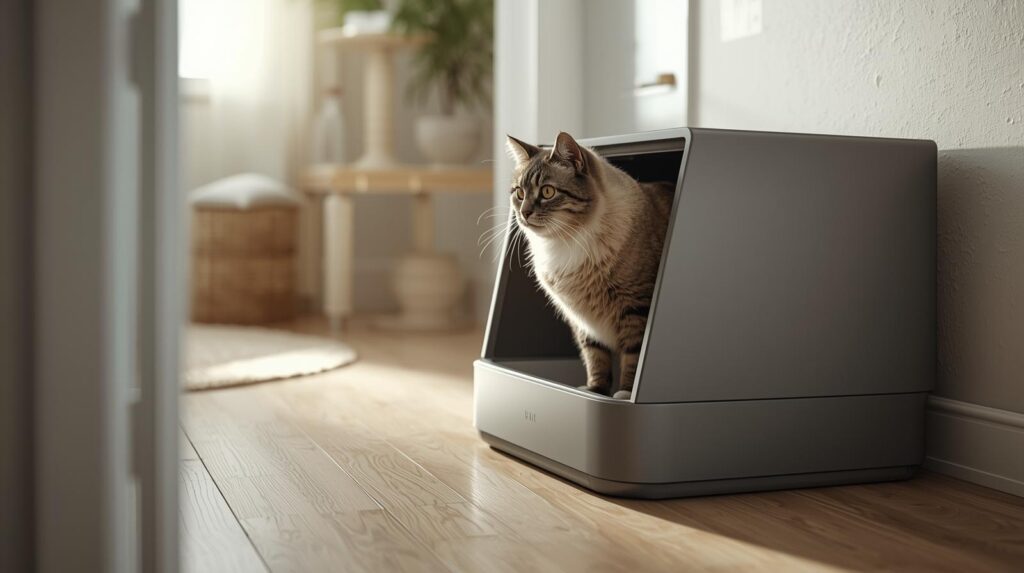
When it comes to keeping the litter box clean, most cat owners are familiar with clay or crystal-based litters. However, in recent years, more people have been exploring natural options, such as corn, pine, walnut, and wheat-based cat litter. Among these, wheat-based has become a popular choice for those seeking an eco-friendly, easy-to-manage, and safe cat litter option.
The big question is: does it perform as well as traditional litter, or is it just a “green” alternative with compromises? In this guide, we’ll look at how wheat cat litter works, its pros and cons, and whether it’s the right fit for you and your cat.
Table of Contents
2. What is Wheat Cat Litter?
Wheat cat litter is made from ground wheat byproducts, turning an everyday grain into a natural alternative to clay. Instead of relying on chemicals or artificial clumping agents, it uses the starches and natural enzymes in wheat to form clumps and neutralize odors.
Some of its key features include:
- Clumping Ability – The starch in wheat helps urine and waste bind together, making scooping easier.
- Natural Enzymes – These enzymes break down odors naturally without added fragrances.
- Biodegradable – Since it’s plant-based, it’s more environmentally friendly and can even be composted in certain conditions.
When compared to traditional clay litter, wheat is much lighter and safer for the environment, but it doesn’t always form as hard clumps. Compared to silica-based litters, it’s softer on your cat’s paws but may require more frequent cleaning to stay fresh.
Our Top Picks in Wheat Litter
Best Overall: sWheat Scoop Multi-Cat Natural Wheat Cat Litter
Best for Odor Control: sWheat Scoop Fast-Clumping Natural Cat Litter
Best Budget-Friendly: PetSafe ScoopFree Wheat Cat Litter
Best Eco-Friendly: SmartCat All Natural Clumping Corn + Wheat Cat Litter
Best for Small Animals & Cats: Oxbow Eco Straw Wheat Straw Litter
Best Disposable Box Combo: Kitty Poo Club Leakproof Disposable Litter Box with Corn & Wheat Litter
3. Pros of Wheat Cat Litter

1. Natural & Biodegradable
Wheat cat litter is made from renewable grain byproducts, which means it’s far more eco-friendly than clay. Instead of sitting in a landfill for decades, it naturally breaks down over time.
2. Flushable/Compostable
Many wheat litters are marketed as flushable or compostable. While you’ll want to check local regulations first, it’s a convenient disposal option compared to heavy clay litter.
3. Clumping Action
The natural starches in wheat help waste clump together, making scooping fairly simple. It’s not as rock-solid as clay, but it gets the job done.
4. Odor Control
Wheat contains natural enzymes that help neutralize ammonia odors without artificial fragrances. For many cat owners, this means less chemical smell and a more natural freshness.
5. Safe & Non-toxic
Because it’s made from food-grade materials, wheat cat litter is generally safe for kittens and cats who may nibble or accidentally ingest small amounts.
6. Low Dust Options
Some brands of wheat litter are virtually dust-free, making them gentler on cats (and humans) with sensitive lungs or allergies.
4. Cons of Wheat Cat Litter
1. Tracking Issues
Wheat litter is lightweight, which makes it more likely to stick to paws and scatter outside the box. You might find yourself sweeping more often.
2. Attracts Bugs
Since it’s grain-based, wheat litter can attract pantry moths, mites, or other pests if not stored properly. This can be a dealbreaker in humid climates.
3. Allergies or Sensitivities
If your cat has a wheat allergy or digestive sensitivity, this type of litter may not be the best choice. While rare, it’s worth considering.
4. Odor Control May Vary
The natural enzymes help with odor, but results aren’t always as strong or long-lasting as clay or silica litters, especially in multi-cat households.
5. Clumping Weakness
The clumps formed by wheat aren’t always as firm as clay. Some users report that they crumble apart during scooping, leaving residue in the box.
6. Price Point
Compared to basic clay litter, wheat litter is often more expensive. While it’s eco-friendly, the higher cost may not fit every budget.
6. Safety Considerations
When choosing a litter, safety is always top of mind — especially if you have kittens or cats with health sensitivities. Here’s what to know about wheat cat litter:
1. Safe for Kittens
Wheat cat litter is generally safe for young kittens because it doesn’t contain harsh chemicals, fragrances, or silica dust. Many cat owners prefer it as a starter litter since it’s gentle on tiny paws.
2. Ingestion Risks
If a kitten or curious cat nibbles on the litter, wheat-based formulas are less dangerous than clay or silica, since they’re made from food-grade materials. That said, you don’t want your cat eating it regularly, as it could still cause mild digestive upset.
3. Wheat Allergies
While rare, some cats may develop allergies or sensitivities to wheat. Symptoms can include itchy skin, excessive grooming, or digestive issues. If you notice these signs after switching litters, it may be worth trying a different natural option like corn or paper.
4. Dust & Respiratory Health
Most wheat litters are advertised as low-dust, which helps reduce respiratory irritation for both cats and humans. However, dust levels can vary by brand. Always use air purifiers for all types of cat litter, it removes dust, smell, odor, and pet hair from the room or cat litter area. If your cat has asthma or a sensitive respiratory system, check reviews carefully before buying.
7. Best Wheat Cat Litter Brands (Review)
If you’re considering switching to wheat cat litter, you’ll want to know which brands perform well. Below are some of the most popular options, along with real pros and cons based on user experiences.
1. sWheat Scoop Multi-Cat Unscented Wheat Cat Litter
Why it stands out:
sWheat Scoop is one of the best-known wheat-based cat litters. It’s made entirely from renewable wheat, making it biodegradable and flushable. Designed especially for homes with multiple cats, it clumps well, controls odors naturally with wheat enzymes, and is free of perfumes or dyes.
Key Features:
- Made from 100% natural wheat
- Strong odor control (enzymes neutralize ammonia)
- Flushable and septic safe
- Unscented and free of chemicals
Pros:
✅ Excellent clumping ability
✅ Eco-friendly and biodegradable
✅ Great for multiple cats
✅ Low dust
Cons:
❌ Clumps may not be as hard as clay litter
❌ Can be slightly more expensive
Best For: Multi-cat households looking for a natural, chemical-free litter.
2. sWheat Scoop Premium+ Wheat Cat Litter
Why it stands out:
This is the upgraded version of sWheat Scoop with enhanced odor control and tighter clumping. It’s especially good if you want stronger performance but still want to stick with a natural wheat formula.
Key Features:
- Premium odor-locking formula
- Improved clumping vs. classic version
- Flushable & septic-safe
- Unscented
Pros:
✅ Stronger odor control than standard wheat litters
✅ Still eco-friendly and safe
✅ Good for cats sensitive to fragrances
Cons:
❌ Slightly pricier than the standard version
Best For: Cat owners who want the benefits of wheat litter but stronger performance for odor and clumping.
3. SmartCat All Natural Clumping Corn + Wheat Cat Litter
Why it stands out:
SmartCat blends corn and wheat for a stronger clumping formula that’s still natural and biodegradable. It’s a good balance between eco-friendly and performance, especially for cat parents who aren’t satisfied with wheat alone.
Key Features:
- Corn + Wheat blend for improved clumping
- Unscented and chemical-free
- Clay-free and lightweight
- Good odor absorption
Pros:
✅ Stronger clumps than wheat-only litter
✅ Lightweight and easy to pour
✅ Safe for cats with sensitivities
Cons:
❌ Can track more than heavier litters
❌ Some cats may need adjustment to texture
Best For: Cat owners who want the eco-friendliness of wheat but with stronger clumping from corn.
4. Oxbow Eco Straw Wheat Straw Litter
Why it stands out:
While not a traditional clumping litter, Oxbow Eco Straw is made from compressed wheat straw pellets. It’s dust-free, biodegradable, and great for multi-pet households since it can also be used for rabbits, guinea pigs, and ferrets.
Key Features:
- Made from compressed wheat straw
- Excellent absorbency without chemicals
- Safe for multiple animals (cats, rabbits, guinea pigs, ferrets)
- Low dust and environmentally friendly
Pros:
✅ Super absorbent and dust-free
✅ Multi-animal use (not just cats)
✅ Long-lasting pellets
Cons:
❌ Doesn’t clump like traditional litter
❌ Some cats may not like the pellet texture
Best For: Pet owners with cats and other small animals who want one safe, natural litter option for all.
5. Kitty Poo Club Corn & Wheat Litter
Why it stands out:
Kitty Poo Club combines convenience with eco-friendly litter. Each box comes with a recyclable, leakproof cardboard litter box plus bags of corn & wheat litter. It’s perfect for busy cat owners, travelers, or those who want a mess-free solution.
Key Features:
- Comes with 2 disposable litter boxes + 2 bags of litter
- Corn & Wheat mix for odor control and clumping
- Recyclable and eco-friendly materials
- Leakproof design
Pros:
✅ Hassle-free — no scrubbing litter boxes
✅ Eco-friendly and recyclable
✅ Great for travel, temporary use, or convenience
Cons:
❌ Can get pricey if used as a permanent solution
❌ Not customizable like permanent litter boxes
Best For: Cat parents who want an all-in-one litter solution that’s disposable and eco-friendly.
Here’s a clean comparison table of the wheat-based litters we shortlisted
| Product | Type | Clumping | Odor Control | Dust Level | Eco-Friendly | Best For |
|---|---|---|---|---|---|---|
| sWheat Scoop Multi-Cat Natural Wheat Cat Litter | Wheat | Yes | Strong | Low Dust | 100% Biodegradable | Multi-cat households, overall use |
| sWheat Scoop Fast-Clumping Natural Cat Litter | Wheat | Fast-Clumping | Excellent | Low Dust | 100% Biodegradable | Odor-sensitive homes |
| PetSafe ScoopFree Wheat Cat Litter | Wheat Crystals Blend | Moderate | Good | Low Dust | Eco-conscious | Budget-friendly option |
| SmartCat All Natural Clumping Corn + Wheat Cat Litter | Corn + Wheat | Yes | Good | Very Low Dust | Renewable & Biodegradable | Eco-friendly homes |
| Oxbow Eco Straw Wheat Straw Litter | Wheat Straw Pellets | No (Absorbent) | Natural Control | Dust-Free | Compostable | Cats, rabbits, and small pets |
| Kitty Poo Club Disposable Litter Box (Corn & Wheat Litter) | Corn + Wheat | Yes | Good | Low Dust | Disposable & Compostable | Convenience and travel |
User Feedback Summary
- Positive reviews highlight the eco-friendliness, natural odor control, and gentleness on cats with allergies or sensitivities.
- Negative reviews often mention tracking issues, softer clumps, and the potential for attracting bugs if not stored properly.
👉 Bottom line: sWheat Scoop is the most tried-and-true wheat cat litter, especially if you want something widely available. However, if you’re in an eco-friendly market, it’s worth checking smaller natural brands that might suit your needs at a better price
8. Who Should Use Wheat Cat Litter?
Wheat cat litter isn’t the perfect fit for every household, but it can be a great choice for certain cat owners. Here’s who will benefit most from making the switch:
1. Eco-Conscious Cat Parents
If you’re looking for a sustainable alternative to clay, wheat litter is biodegradable, compostable, and made from renewable resources. It’s a good way to reduce your household’s environmental footprint.
2. Cats with Dust Sensitivities
Most of the cat litters are dusty, hence harmful to cats and humans and may trigger sneezing, allergies, or even asthma in sensitive cats. Wheat litters (especially low-dust formulas) are a gentler option for cats and humans alike.
3. Households with Kittens or Seniors 🐱
Because it’s non-toxic and made from food-grade materials, wheat litter is generally safe for kittens that may accidentally ingest small amounts, as well as older cats with more delicate paws.
Who Should Avoid Wheat Litter?
- Homes prone to bug problems (since it’s grain-based and can attract pests).
- Owners of very picky cats who dislike changes in texture or smell.
- Multi-cat households that need maximum odor control, as wheat litter may not always hold up as strongly as clay or silica.
5. Wheat Cat Litter vs. Other Types
When deciding if wheat cat litter is right for your home, it helps to see how it stacks up against other popular options.
1. Wheat vs. Clay
- Wheat: Eco-friendly, biodegradable, lighter, and safer if ingested.
- Clay: Offers very firm clumps and strong odor control but is heavy, dusty, and non-biodegradable.
👉 Verdict: Choose wheat if you care about sustainability, but clay wins for clumping power.
2. Wheat vs. Corn
- Wheat: Natural enzymes help with odor, clumps moderately well, less likely to mold.
- Corn: Also natural and biodegradable, but can attract mold and even aflatoxin (a harmful fungus) in humid climates.
👉 Verdict: Both are eco-friendly, but wheat tends to be safer in terms of mold issues.
3. Wheat vs. Pine Pellets
- Wheat: Clumps and scoops more like traditional litter, softer on paws.
- Pine: Great at absorbing odor naturally but doesn’t clump well and breaks down into sawdust, which some cats dislike.
👉 Verdict: Wheat is better for owners who prefer clumping; pine is better for natural odor absorption.
4. Wheat vs. Paper Litter
- Wheat: Clumps for easier scooping and offers natural odor control.
- Paper: Highly absorbent, soft, and dust-free, but doesn’t clump at all. Often used for kittens or post-surgery recovery.
👉 Verdict: Wheat works better for everyday use; paper is best for temporary or medical situations.
This comparison shows that wheat litter lands in the middle — more eco-friendly than clay, safer than corn in humid climates, and easier to scoop than pine or paper.
9. Alternatives to Wheat Cat Litter
If wheat cat litter doesn’t seem like the right fit, there are plenty of other natural and traditional options to explore. Each type has its own pros and cons:
1. Corn Cat Litter
- ✅ Natural, biodegradable, clumps well.
- ❌ Can attract mold and pests in humid areas.
2. Pine Cat Litter
- ✅ Excellent at absorbing odors, chemical-free, and lightweight.
- ❌ Doesn’t clump as well and breaks down into sawdust.
3. Walnut Cat Litter
- ✅ Made from crushed walnut shells, strong odor control, eco-friendly.
- ❌ Dark color makes it harder to see clumps, can be dusty.
4. Paper Cat Litter 📄
- ✅ Soft, highly absorbent, dust-free — great for kittens or cats recovering from surgery.
- ❌ No clumping, requires frequent box changes.
5. Silica Gel Litter 💎
- ✅ Excellent odor control, long-lasting, low tracking.
- ❌ Not biodegradable, some cats dislike the texture.
Bottom line: If you want eco-friendly clumping, corn or walnut are the closest to wheat. If odor control is your top priority, silica or pine may work better. For kittens or medical recovery, paper is the gentlest option.
10. Final Verdict – Is Wheat Cat Litter Worth It?
Wheat cat litter offers a natural, biodegradable alternative to traditional clay, making it an attractive option for eco-conscious cat owners. It’s generally safe, gentle on paws, and provides decent clumping and odor control without harsh chemicals.
That said, it does come with trade-offs. Tracking can be a hassle, clumps may not be as firm as clay, and some households may struggle with bugs or allergies. It’s also usually more expensive than standard litters.
So, is it worth it?
- ✅ Yes, if you value sustainability, want a safer choice for kittens or sensitive cats, and don’t mind a little extra sweeping.
- ❌ Maybe not, if you need heavy-duty odor control, live in a humid area prone to pests, or want the strongest possible clumping action.
At the end of the day, wheat cat litter strikes a balance between eco-friendliness and practicality. The best way to know if it works for you is to try a small bag first and see how both you and your cat adjust.
Frequently Asked Questions (FAQs) about Wheat Cat Litter
1. Is wheat cat litter safe for kittens?
Yes. Since it’s made from natural, food-grade materials, wheat litter is generally safe for kittens. It’s non-toxic and softer on their paws compared to clay.
2. Can cats eat wheat cat litter?
While it’s not harmful in small amounts, cats shouldn’t eat litter regularly. If your cat ingests large amounts, it could cause stomach upset. Always monitor curious kittens.
3. Does wheat cat litter control odor well?
Wheat contains natural enzymes that help neutralize odors. It works for most homes, but some cat owners find clay or silica litters provide stronger odor control, especially in multi-cat households.
4. Is wheat cat litter flushable?
Some brands market it as flushable, but this depends on local plumbing and regulations. To be safe, most experts recommend disposing of used litter in the trash or composting (for non-toxic waste only).
5. Does wheat cat litter attract bugs?
Because it’s grain-based, it can attract pantry moths, maggots or mites if not stored properly. Keeping it in a sealed container helps prevent pests.
6. How does wheat cat litter compare to clay?
Clay clumps harder and provides strong odor control, but isn’t eco-friendly. Wheat is biodegradable, lighter, and safer if ingested, but may track more and clump less firmly.
7. Can I compost wheat cat litter?
Yes, unused or urine-soiled wheat litter can often be composted. However, waste containing cat feces should not be used in compost for food gardens due to bacterial risks.
8. Is wheat cat litter dusty?
Most wheat litters are low-dust, making them a good option for cats with respiratory sensitivities. However, dust levels can vary by brand, so it’s worth checking reviews.
9. How long does wheat cat litter last?
It typically lasts 2–3 weeks in a single-cat household before needing a full change. With multiple cats, more frequent changes may be necessary.
10. Is wheat cat litter expensive?
Yes, it’s usually more expensive than clay litter but comparable to other natural options like corn or walnut.


